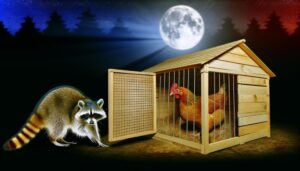How Do Raccoons Get Into Your House?
Raccoons often gain entry into homes through common vulnerabilities like chimneys, attics, damaged roofs, and gaps in walls or crawl spaces. They can exploit weakened window screens, enter through garages, or find their way in via unsealed vents and ducts.
Additionally, basement openings present another access point for these persistent creatures. To prevent raccoons from invading your home, conduct regular inspections, promptly repair any damage, and use raccoon-proof materials.
Sealing gaps with caulk or steel wool is also effective. For more detailed strategies on safeguarding your home, continue to the next section.

Key Takeaways
- Raccoons enter homes through structural vulnerabilities like chimneys, attics, and wall gaps.
- Poor maintenance and weather damage create entry points for raccoons.
- Raccoons exploit unsecured vents, exhausts, and crawl spaces to gain access.
- They can manipulate pet doors without locking mechanisms.
- Tree branches near roofs provide easy access for raccoons.
Chimney Invasions
Chimney invasions by raccoons pose a significant risk to both the structural stability of your home and the well-being of its occupants. These nocturnal creatures are skilled climbers, often seeking shelter in chimneys, where they may establish nests and reproduce. The presence of raccoons can result in structural harm, such as displaced bricks or flue blockages, which compromise the chimney's functionality.
Moreover, raccoons harbor parasites and illnesses, including raccoon roundworm and rabies, presenting significant health hazards. To address these risks, homeowners should install a durable chimney cap and routinely examine for signs of intrusion. Enlisting a professional wildlife removal service guarantees a humane and efficient eviction, safeguarding the safety and integrity of your home.
Attic Entries
In addition to chimneys, raccoons frequently gain access to homes through attic entries, exploiting vulnerabilities in roofing and eaves to establish their nests.
These intelligent creatures are adept at identifying weak spots, such as loose vents, soffits, and fascia boards. Homeowners should routinely inspect these areas for signs of damage or tampering.
Installing sturdy, raccoon-proof materials like metal mesh over vents and ensuring all eaves are securely fastened can deter entry. Additionally, trimming tree branches away from the roofline limits access points.
Promptly addressing any minor repairs not only prevents raccoons from settling in but also maintains the overall integrity of the home. Regular maintenance and vigilance are key to safeguarding attics from these persistent invaders.
Roof Damage
How can homeowners effectively address roof damage to prevent raccoons from gaining entry? Regular inspections and prompt repairs are critical. Look for broken shingles, loose flashing, and gaps around vents. These issues provide easy access points for raccoons seeking shelter. Implementing a proactive maintenance plan can mitigate these risks.
| Issue | Cause | Solution |
|---|---|---|
| Broken Shingles | Weather damage | Replace promptly |
| Loose Flashing | Poor installation | Re-secure or replace |
| Gaps Around Vents | Wear and tear | Seal with appropriate materials |
Wall Gaps
Addressing roof damage is essential, but homeowners must also pay close attention to wall gaps, as these can be substantial entry points for raccoons seeking access to the interior of the house.
Raccoons are adept climbers and can exploit even the smallest gaps in your walls. Regularly inspect the exterior of your home for cracks, holes, and any deterioration in the siding or masonry. Seal any discovered gaps with appropriate materials such as caulk or steel wool, which raccoons find challenging to chew through.
Additionally, make sure that vents and exhausts are securely covered with sturdy mesh. By taking these proactive measures, you can markedly reduce the risk of raccoons entering your home through wall gaps.
Crawl Spaces
Crawl spaces are common entry points for raccoons, primarily through vents and damaged foundations. Ensuring that all vents are securely covered and checking the foundation for any cracks or holes can prevent these animals from gaining access.
Regular inspections and timely repairs are essential to avoid infestations.
Access Through Vents
Vents and crawl spaces often provide raccoons with an easy entry point into homes, making it significant to secure these areas effectively. Raccoons are skilled climbers and can exploit any weaknesses in vent covers or gaps in crawl spaces to gain access.
To prevent this, make sure all vent covers are made of strong materials such as metal, and check that they are securely fastened. Additionally, installing a fine mesh screen behind the vent cover can add an extra layer of protection. Regular maintenance is essential; inspect vents and crawl spaces periodically for signs of wear or damage.
Damaged Foundation Entry
Another common entry point for raccoons is through damaged foundations and compromised crawl spaces, which can provide easy access to the interior of homes. These areas often become vulnerable due to wear and tear, moisture damage, or poor construction, creating gaps that raccoons can exploit. Homeowners should regularly examine and uphold these sections to prevent intrusion.
- Examine for Cracks and Holes: Regularly check your foundation and crawl spaces for any visible openings.
- Seal Gaps Immediately: Use appropriate materials like concrete patches or metal mesh to seal identified vulnerabilities.
- Maintain Proper Ventilation: Confirm that vent covers are intact and secure, preventing raccoons from squeezing through.
Pet Doors
Pet doors can serve as easy entry points for raccoons, particularly during their increased nighttime activity.
Ensuring the security of pet doors is essential to prevent these opportunistic intruders from accessing your home.
Implementing specialized locking mechanisms or electronic pet doors can effectively mitigate this risk.
Easy Entry Points
Ensuring that pet doors are securely sealed and monitored is essential to prevent raccoons from using them as convenient entry points into your home. These clever creatures can easily manipulate unsecured or poorly designed pet doors, leading to uninvited access.
To mitigate this issue, consider the following measures:
- Install Electronic Pet Doors: These doors only open for pets wearing a specific electronic collar, effectively barring raccoons.
- Use Locking Mechanisms: Regularly lock pet doors at night or when not in use to prevent raccoon entry.
- Upgrade to High-Quality Materials: Choose durable, raccoon-resistant pet doors that are difficult for these animals to breach.
Nighttime Activity Increase
As nocturnal animals, raccoons are particularly active at night, making it essential to secure pet doors during these hours to prevent their entry.
Raccoons are adept at finding easy access points, and pet doors can be an inviting gateway if not properly managed. These clever creatures use their dexterous paws to manipulate simple locks and closures, gaining entry into homes in search of food and shelter.
Homeowners who wish to provide safety and comfort to their pets must be vigilant about nighttime security. Ensuring that pet doors are monitored and adequately safeguarded can notably reduce the risk of unwanted raccoon intrusions, thereby maintaining a safe and secure living environment for all household members, both human and animal.
Secure Pet Doors
Securing pet doors effectively is a key measure in preventing raccoons from gaining access to your home. Raccoons are adept at exploiting unsecured pet doors, which can lead to significant nuisance and potential health risks.
To guarantee your pet door does not become an entry point for these clever intruders, consider the following expert recommendations:
- Electronic pet doors: These doors use a sensor on your pet's collar to allow entry exclusively for your pet.
- Manual locks: Install a pet door with a manual locking mechanism to secure it during nighttime or when not in use.
- High-quality construction: Invest in a durable, raccoon-resistant pet door designed to withstand tampering.
Implementing these measures will help safeguard your home while still accommodating your pets' needs.
Window Screens
Window screens serve as a critical barrier in preventing raccoons from gaining entry into your home through open windows. High-quality, durable screens are essential to withstand the persistent efforts of these resourceful animals.
Regularly inspect screens for any signs of wear or damage, such as tears, loosening, or gaps, and promptly repair or replace compromised sections. Additionally, make sure that screens are securely fitted into the window frame to prevent raccoons from prying them loose.
For added protection, consider using reinforced or metal mesh screens, which provide greater resistance against clawing and biting. By maintaining and upgrading window screens, you can significantly lower the risk of unwanted raccoon intrusions and safeguard your home environment.
Garage Access
Garages often present an easy entry point for raccoons, making it crucial to implement robust security measures to prevent access. These clever animals can exploit even the smallest gaps or weaknesses in garage doors and structures.
To fortify your garage against raccoon intrusions, consider the following preventive measures:
- Seal all entry points: Inspect your garage for gaps, cracks, and holes, and seal them with caulk or hardware cloth.
- Install sturdy doors: Make sure that your garage door is made of durable materials and has no gaps at the bottom.
- Secure trash and food: Store garbage and pet food in sealed, raccoon-proof containers to eliminate attractants.
Taking these steps can significantly reduce the likelihood of raccoons gaining access to your garage.
Vents and Ducts
Vents and ducts provide raccoons with hidden entryways into your home, necessitating thorough inspections and fortifications to prevent these opportunistic intruders. These animals are adept at squeezing through small openings and can cause significant damage once inside. Regularly inspect vents, ducts, and exhaust pipes for signs of tampering or wear. Use durable materials like metal mesh to cover these openings, ensuring they are securely fastened.
| Issue | Solution |
|---|---|
| Damaged duct covers | Replace with metal mesh |
| Loose vent fittings | Secure with screws and sealant |
| Unscreened openings | Install vent covers |
Maintaining a vigilant approach to these potential entry points is essential. By taking preventative measures, you can safeguard your home and serve those you care for by ensuring a raccoon-free environment.
Basement Openings
Basement openings are frequently overlooked entry points that raccoons can exploit to gain access to your home. These nocturnal animals are adept climbers and can easily navigate to basement windows, vents, or even small fissures in the foundation. Securing these areas is vital for preventing unwanted intrusions.
To safeguard your home, consider the following measures:
- Install window well covers: These prevent raccoons from accessing basement windows, offering a physical barrier.
- Seal fissures and gaps: Inspect the foundation for any openings and use appropriate sealants to close them.
- Secure vent covers: Guarantee all basement vents are properly covered with durable materials that raccoons cannot breach.
Implementing these steps will significantly reduce the likelihood of raccoon entry through basement openings.
Conclusion
Concluding the exploration of entry points for raccoons into residential spaces, it is evident that these animals exploit a variety of structural vulnerabilities.
Remarkably, studies indicate that up to 80% of raccoon home invasions occur through attic entries and roof damage. This statistic underscores the necessity for regular home inspections and maintenance.
Sealing potential access points such as chimneys, vents, and wall gaps can notably reduce the likelihood of raccoon intrusions, thereby safeguarding residential environments.






